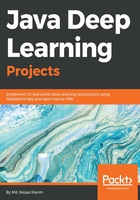
Working principles of ML algorithms
We now refer to a famous definition of ML by Tom M. Mitchell (Machine Learning, Tom Mitchell, McGraw Hill), where he explained what learning really means from a computer science perspective:
"A computer program is said to learn from experience E with respect to some class of tasks T and performance measure P, if its performance at tasks in T, as measured by P, improves with experience E."
Based on this definition, we can conclude that a computer program or machine can do the following:
- Learn from data and histories
- Improve with experience
- Iteratively enhance a model that can be used to predict outcomes of questions
Since they are at the core of predictive analytics, almost every ML algorithm we use can be treated as an optimization problem. This is about finding parameters that minimize an objective function, for example, a weighted sum of two terms like a cost function and regularization. Typically, an objective function has two components:
- A regularizer, which controls the complexity of the model
- The loss, which measures the error of the model on the training data.
On the other hand, the regularization parameter defines the trade-off between minimizing the training error and the model's complexity in an effort to avoid overfitting problems. Now, if both of these components are convex, then their sum is also convex; it is non-convex otherwise. More elaborately, when using an ML algorithm, the goal is to obtain the best hyperparameters of a function that return the minimum error when making predictions. Therefore, using a convex optimization technique, we can minimize the function until it converges towards the minimum error.
Given that a problem is convex, it is usually easier to analyze the asymptotic behavior of the algorithm, which shows how fast it converges as the model observes more and more training data. The challenge of ML is to allow training a model so that it can recognize complex patterns and make decisions not only in an automated way but also as intelligently as possible. The entire learning process requires input datasets that can be split (or are already provided) into three types, outlined as follows:
- A training set is the knowledge base coming from historical or live data used to fit the parameters of the ML algorithm. During the training phase, the ML model utilizes the training set to find optimal weights of the network and reach the objective function by minimizing the training error. Here, the back-prop rule (or another more advanced optimizer with a proper updater; we'll see this later on) is used to train the model, but all the hyperparameters are need to be set before the learning process starts.
- A validation set is a set of examples used to tune the parameters of an ML model. It ensures that the model is trained well and generalizes towards avoiding overfitting. Some ML practitioners refer to it as a development set or dev set as well.
- A test set is used for evaluating the performance of the trained model on unseen data. This step is also referred to as model inferencing. After assessing the final model on the test set (that is, when we're fully satisfied with the model's performance), we do not have to tune the model any further but the trained model can be deployed in a production-ready environment.
A common practice is splitting the input data (after necessary pre-processing and feature engineering) into 60% for training, 10% for validation, and 20% for testing, but it really depends on use cases. Also, sometimes we need to perform up-sampling or down-sampling on the data based on the availability and quality of the datasets.
Moreover, the learning theory uses mathematical tools that derive from probability theory and information theory. Three learning paradigms will be briefly discussed:
- Supervised learning
- Unsupervised learning
- Reinforcement learning
The following diagram summarizes the three types of learning, along with the problems they address:

Types of learning and related problems